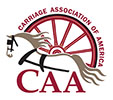Q. In carriage and coaching classes at shows, is it correct for the horses’ mane to be braided?
A. At one time the Rule Book for the American Horse Shows Association was quite clear on this point, at least so far as the classes for Ladies’ Phaetons and Gigs were concerned. In both cases the rule was that manes should not be braided. This ruling was made because it was considered “bad form” for a lady or a gentleman to drive horses with braided manes, – this was only done by dealers. If we look at pictures taken at horse shows in this country before 1940 we will find that this rule was invariably followed, and in some other classes as well when amateurs drove.

For Park Drags and Road Coaches nothing seems to have been clearly laid down, but photographs taken at shows both in this country and in England show horses in Park Drags with unbraided manes in almost every case. The one exception I have found is a picture of Bertram Mills driving Miss Ross’s coach at a show about 1910, and the manes are braided. This may have because the horses, or some of them, were to be shown in other harness classes on the same day. By 1910 it became general practice to braid manes for Hackney harness classes.

Whether or not horses’ manes are braided for Pleasure Driving classes is a matter of taste. A horse with a well-laid and neatly trimmed mane looks best, but a braided mane certainly looks better than one that is standing up or laid part on one side, part on the other.
In fine harness classes it is usual for horses to have full manes with the forelock and a single braid at the top of the mane done with colored ribbon. This is a show ring fashion and would be inappropriate for horses shown in pleasure driving classes.
From The Carriage Journal, Vol 20, No 4, Spring 1983
